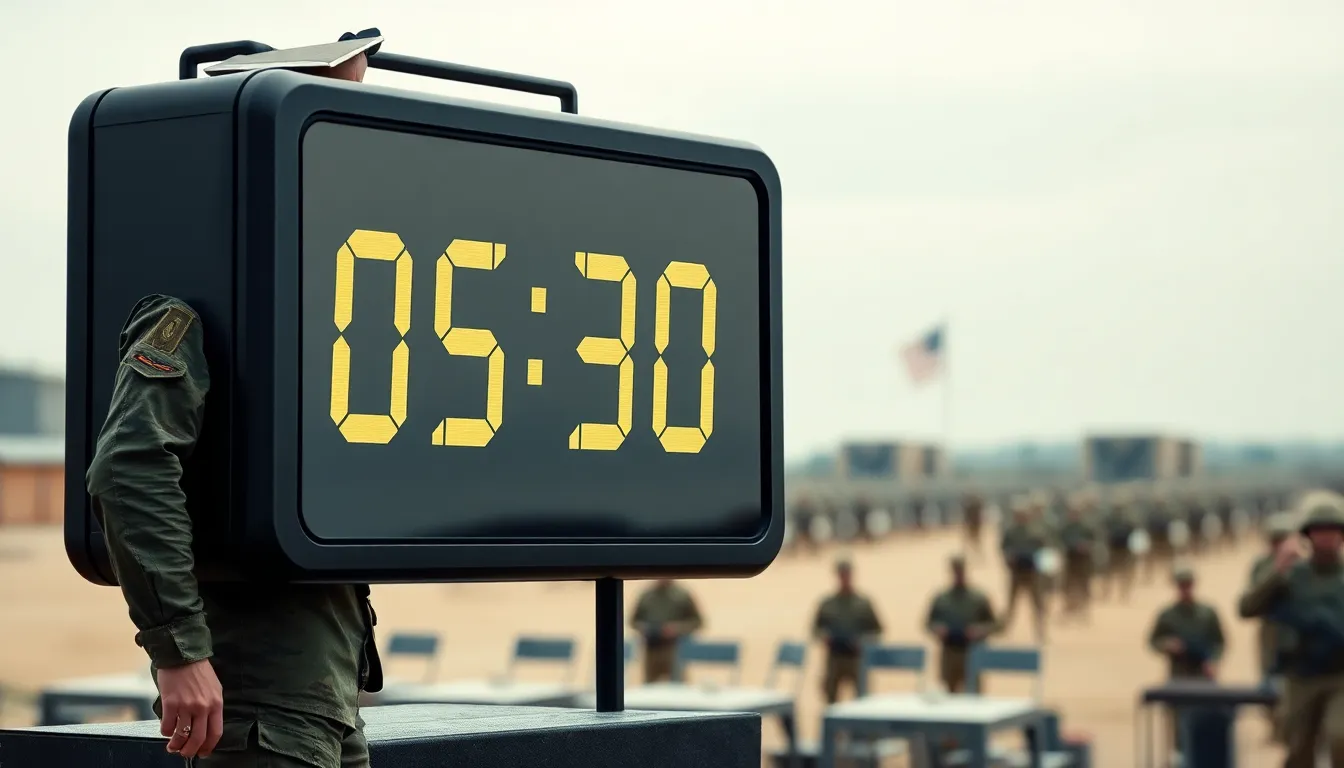When the clock strikes 5:30 in military time, the world transforms into a battlefield of numbers and precision. If you’ve ever found yourself scratching your head over the 24-hour clock, you’re not alone. It’s like trying to decipher a secret code while half-asleep. But don’t worry, understanding military time is easier than finding a matching pair of socks in the laundry!
Table of Contents
ToggleUnderstanding Military Time
Military time operates on a 24-hour clock format. This system eliminates the need for AM and PM indicators. Each hour is numbered sequentially from 00 to 23. For instance, 5:00 AM translates to 0500, while 5:00 PM converts to 1700.
Converting civilian time to military time is straightforward. Add 12 to any hour after noon to determine the military equivalent. For example, 1:00 PM becomes 1300, and 11:00 PM converts to 2300. Understanding this pattern reduces confusion significantly.
Reading military time involves recognizing the four-digit format. The first two digits represent hours, and the last two digits signify minutes. Clarity comes from noting that 5:30 PM is expressed as 1730 in military time.
Using military time enhances communication, particularly in fields like aviation, healthcare, and the military. Precision matters, and relying on a 24-hour format minimizes misunderstandings. Context always clarifies what time is referenced, especially when scheduling or coordinating with others.
Adopting military time can streamline daily routines. It simplifies tasks such as setting alarms or planning events. Familiarity with this system leads to more efficient time management. Individuals can apply military time effortlessly across various situations.
Converting Standard Time to Military Time

Converting standard time to military time involves a few straightforward steps. Understanding the basics simplifies the process significantly.
The Basics of Military Time
Military time uses a 24-hour clock format. Hours range from 00 for midnight to 23 for 11 PM. Standard time formats include AM and PM, while military time omits these indicators. For example, 1:00 PM converts to 13:00 in military time. Evening times increase sequentially from 12:00, such as 6:00 PM becoming 18:00. Familiarity with this format may improve communication, especially in professional settings.
How to Read Military Time
Reading military time requires attention to the four-digit format. The first two digits indicate hours, while the last two represent minutes. For instance, 5:30 in military time is 05:30. Zero before the hour clarifies early morning hours. After noon, simply add 12 to the hour for conversion. For example, 3:00 PM becomes 15:00. Understanding these shifts helps with accurate time management in various contexts.
Why Use Military Time?
Military time simplifies communication and minimizes misunderstandings regarding time representation. Its clarity benefits various professions and daily schedules.
Advantages of Military Time
Enhanced clarity stands at the forefront of military time’s advantages. This format eliminates AM and PM confusion, offering a straightforward numerical system. Precise timing proves vital in critical situations; thus, operations rely heavily on military time to avoid errors. Time management improves as individuals adapt to the 24-hour clock, leading to more organized routines. Simplifying travel and scheduling, military time aids in effective planning across different contexts.
Common Usage in Various Fields
Military time frequently appears in numerous professional settings. Aviation employs this system to ensure flight schedules are communicated with absolute precision. Healthcare professionals utilize military time in patient charts, facilitating accurate medication administration. Emergency services rely on military time to coordinate operations through clear time references. Personnel in the military use it for orders and scheduling, affirming its importance in high-stakes environments. The versatility of military time allows it to fit seamlessly into diverse sectors, enhancing efficiency and reducing the risk of miscommunication.
5:30 in Military Time
Understanding 5:30 in military time clarifies communication, especially in professional fields. This time converts to 17:30, as military time counts from midnight to midnight without AM or PM indicators.
Conversion Details
To convert civilian time to military time, recognize that hours after noon require an addition of 12. Since 5:30 PM falls within this range, adding 12 results in 17:30. For hours before noon, the conversion remains unchanged, retaining the original hour format. This framework simplifies time representation, ensuring consistent communication across various settings.
Practical Examples
Many industries effectively utilize military time for scheduling. For instance, flight schedules often display times like 17:30, representing a 5:30 PM departure. Healthcare settings also use this system, ensuring shift changes happen precisely at times like 17:30, eliminating potential confusion. Public transportation, such as trains or buses, employs military time, helping passengers understand schedules quickly and efficiently.
Understanding military time is a valuable skill that can greatly enhance clarity and efficiency in communication. By mastering the 24-hour clock format, individuals can avoid confusion and streamline their daily routines. The simplicity of converting civilian time to military time makes it accessible for everyone.
As more people recognize the benefits of this system, its use in various professional fields continues to grow. Embracing military time not only improves time management but also fosters precision in critical situations. Adopting this format can lead to better coordination and fewer misunderstandings, making it an essential tool in today’s fast-paced world.





